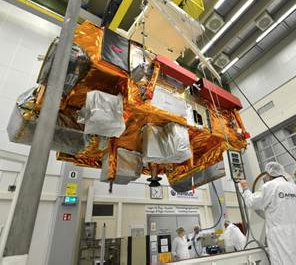
Payload module of MetOp-C is being prepared for transport. Photo: Airbus DS GmbH /A. Ruttloff

Experts from different locations will be testing Airbus Defence and Space's MetOp-C module, the polar-orbiting weather satellite, aka the "brain". This is a big brain to be shipped to various companies that weighs around 2.1 tonnes, contains 10 measuring instruments together with their control systems that are used for issuing commands and monitoring instruments, formatting data, encrypting and storing the data as well as transmitting the information to Earth.
The first stop will take place in the next six months of 2017 in which the payload module (PLM) will be tested in space conditions at the Space Research and Technology Center (ESTEC) of the European Space Agency (ESA) in Noordwijk in the Netherlands. There, around 30 employees from the Airbus Defence and Space site in Friedrichshafen will carry out comprehensive functional tests on the PLM of the third and last MetOp satellite of the first generation.
After than the module's second journey is to the Toulouse Airbus Defence and Space site, where it will join up with the service module (SVM). The service module houses the main computer, power supply, attitude and thermal control systems as well as systems for controlling communications with the ground station. MetOp-C is currently planned to be launched in October 2018.
MetOp is a series of operational polar-orbiting weather satellites that orbit the Earth at an altitude of around 800 kilometers (497 miles). The first satellite in the series, MetOp-A, was launched on October 19, 2006 and was followed by MetOp-B on September 17, 2012. Both ‘weatherstations’ have since been operating successfully in space.
MetOp has many capabilities, for example as an infrared scanner it provides three-dimensional data on temperatures and humidity in the Earth’s atmosphere with unparalleled accuracy. Approaching storms can therefore be detected several hours in advance. The instrument can also collect data on greenhouse gases, such as carbon dioxide, carbon monoxide or methane on a total of 8,400 spectral channels. The tasks of MetOp include near-surface wind measurement over the oceans, the observation of sea ice distribution and the monitoring of the ozone layer in the stratosphere. But MetOp also transmits other signals and receives measurement data from ships, buoys and research stations as well as signals from people in distress.
Within the EUMETSAT Polar System (EPS), MetOp forms part of the global meteorological satellite network in cooperation with the National Oceanic and Atmospheric Administration (NOAA), which also supplies some of the instruments. The MetOp series satellites have been jointly developed by the European Organization for the Exploitation of Meteorological Satellites (EUMETSAT) and ESA. MetOp is operated by EUMETSAT. The satellites are built under the industrial leadership of Airbus Defence and Space.
https://airbusdefenceandspace.com

